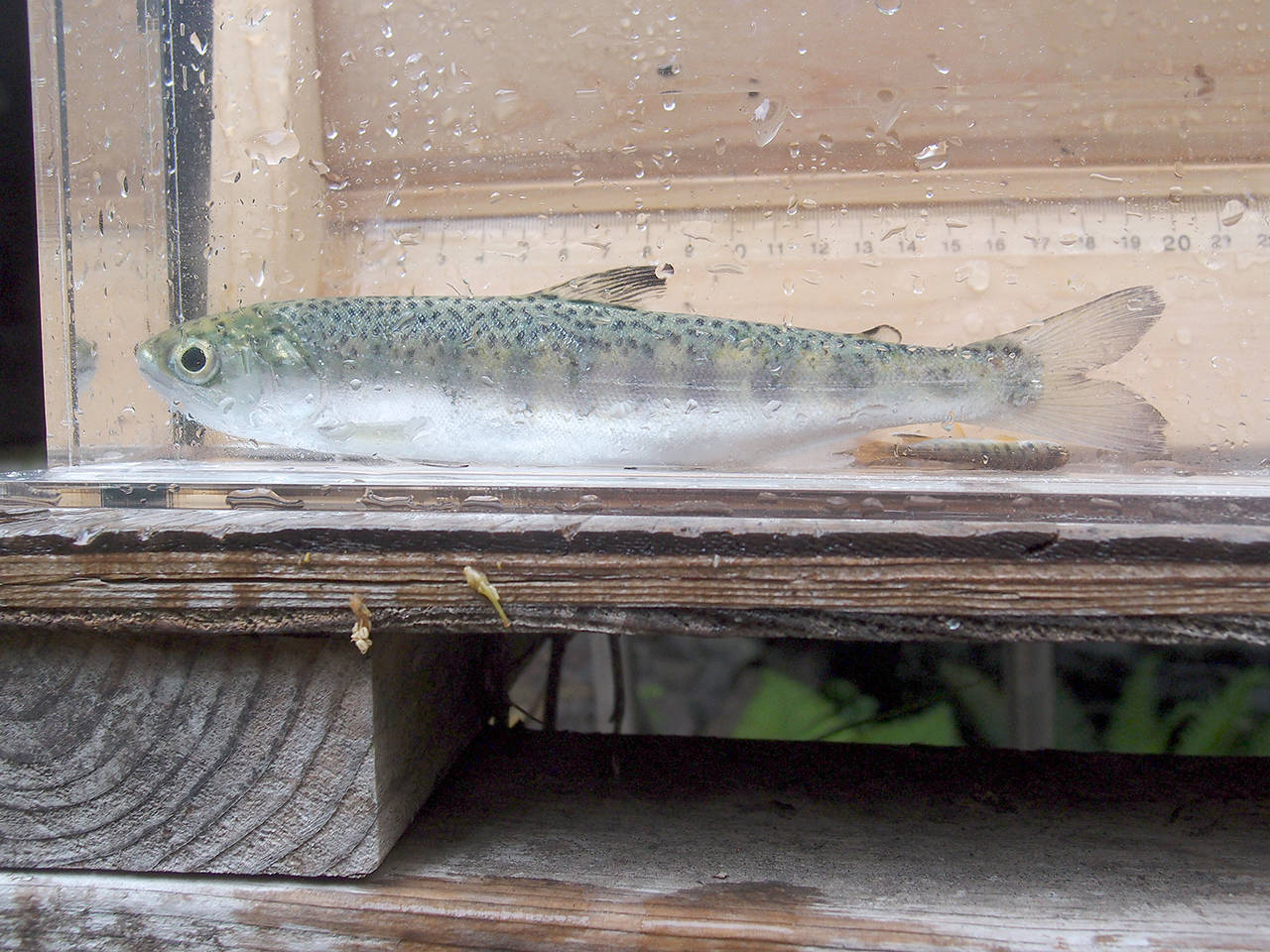A FISH SUCCESS story while anglers wait for silvers to stream down the Strait of Juan de Fuca in bigger numbers: coho catch totals are improving, but pinks are still the clubhouse leader thus far.
Lower Elwha Klallam Tribal biologists discovered larger-than-expected coho smolts migrating out of Lake Sutherland in the spring.
Smolts up to 10 inches in length were trapped in the tribe’s fyke net fish trap during annual monitoring of Indian Creek, the tributary which connects Lake Sutherland to the Elwha River.
Coho smolts are typically half that size.
“Coho do well in low energy environments such as lakes, with lots of food such as zooplankton and other fish, so they’re going to get big,” said Mike McHenry, the tribe’s habitat program manager.
“I suspect that’s what’s happening — their diet starts with zooplankton and insects, but as they grow, they will switch to eating fish, which Lake Sutherland is filled with, such as red-side shiner and kokanee. And this is good because the bigger the fish, the higher survival rate.”
Indian Creek is proving to be highly productive, McHenry said. Raw catch data at a smolt trap in lower Indian Creek shows 5,500 coho smolts caught between January and May.
The trap will continue fishing through the end of August.
Progeny spawning success
In 2017, a Lake Sutherland property owner filmed six coho spawning in Falls Creek, a small creek that feeds into the lake, said Rebecca Paradis, a project biologist for the tribe.
“Three of them had Floy tags, indicating they were surplus adult coho relocated from the tribe’s hatchery, and three of them didn’t have tags,” she said. “That tells us these coho found each other in Indian Creek, swam to the lake and then up Falls Creek. Now, two years later, we’re seeing these huge smolts.”
The tribe has been monitoring Indian Creek since work began in 2011 to remove the two dams on the Elwha River.
Soon after, the tribe moved surplus adult coho salmon from its hatchery in the Elwha River to Indian Creek and the Little River to kick start coho spawning.
As a result, the majority of the coho returns used to be hatchery fish, but now they are mostly naturally produced, McHenry said.
“We don’t need to push fish in the creek anymore,” he said. “The run has essentially evolved into a natural life history.”
Even though coho salmon typically are river spawners, they will use lakes if available, Paradis said. Other systems in Washington where coho have access to lakes via creeks, such as Snow Creek in Discovery Bay, have shown to be productive.
Hood Canal
Quilcene’s Ward Norden, a former fisheries biologist and owner of Snapper Tackle Co., has been seeking out hatchery coho on Quilcene Bay.
“Not too much action on Quilcene Bay yet in spite of the large number of anglers making the long trek from East Quilcene Road to the mouth of the Big Quilcene River,” Norden said. “It is still a bit early yet. Nevertheless, my wife and I went out to our favorite beach casting spot farther out in the Bay and saw the first school of coho for the season I have seen pass by. I quickly hooked and lost one on a heavy homemade spinner. It only gets better for the next four weeks.”
Norden had some advice for anglers making that walk across the tideflats.
“A word to the wise for anglers making the trek from East Quilcene Road across the [bay],” Norden said. “Leave at least two hours before low tide and head back an hour after high tide no matter how good fishing is.
“It is a really long walk all the way back through town if you wait too long. If you have to be rescued, it is really embarrassing.”
Still time for hunters ed
There is still time for prospective hunters to complete hunter education coursework in advance of the fall season.
Hunters born after Jan. 1, 1972 must show proof of completion of hunter education before buying their first Washington hunting license.
WDFW offers both traditional and online options to complete the hunter education requirement.
There are no in-class hunter education courses scheduled for the North Olympic Peninsula, but prospective hunters could take the online course — which offers the same content, but on the student’s schedule.
Students who take the online course are required to complete an in-person field skills evaluation led by certified instructors.
There is one field skills evaluation planned soon on the North Olympic Peninsula — from 8 a.m. to 2 p.m. Sept. 14 at Gierin Creek Farm, 621 Port Williams Road in Sequim.
This class is filling fast — 11 of 20 seats remain open as of Thursday afternoon.
Register online at www.register-ed.com/events/view/147981.
To learn about hunter education requirements or find a course, new hunters should visit the WDFW hunter education webpage at wdfw.wa.gov/hunting/requirements/education/basic.
Halibut process begins
is hosting two public meetings to discuss season structure and proposed dates for the 2020 sport halibut season.
The meetings will be held Thursday and Oct. 28, from 9 a.m. to noon at the Montesano City Hall, 112 N. Main St.
At Thursday’s meeting, state halibut managers will review the 2019 season and work with stakeholders to develop a range of preliminary options focused on general concepts, such as ways to extend the season length and maximize fishing opportunity.
At the second meeting on Oct. 28, in addition to refining the options developed at the first meeting, department staff will collect further public input, review tide calendars for next spring and select specific season dates that attempt to balance needs across various fishing communities and charter and private fishing interests.
These meetings will allow the state to gather stakeholder input prior to meetings of the Pacific Fishery Management Council (PFMC) in September and November.
For more information on the halibut season-setting process visit PFMC’s website at www.pcouncil.org/pacific-halibut/background-information.
________
Sports reporter/columnist Michael Carman can be contacted at 360-417-3525 or mcarman@peninsuladailynews.com.

